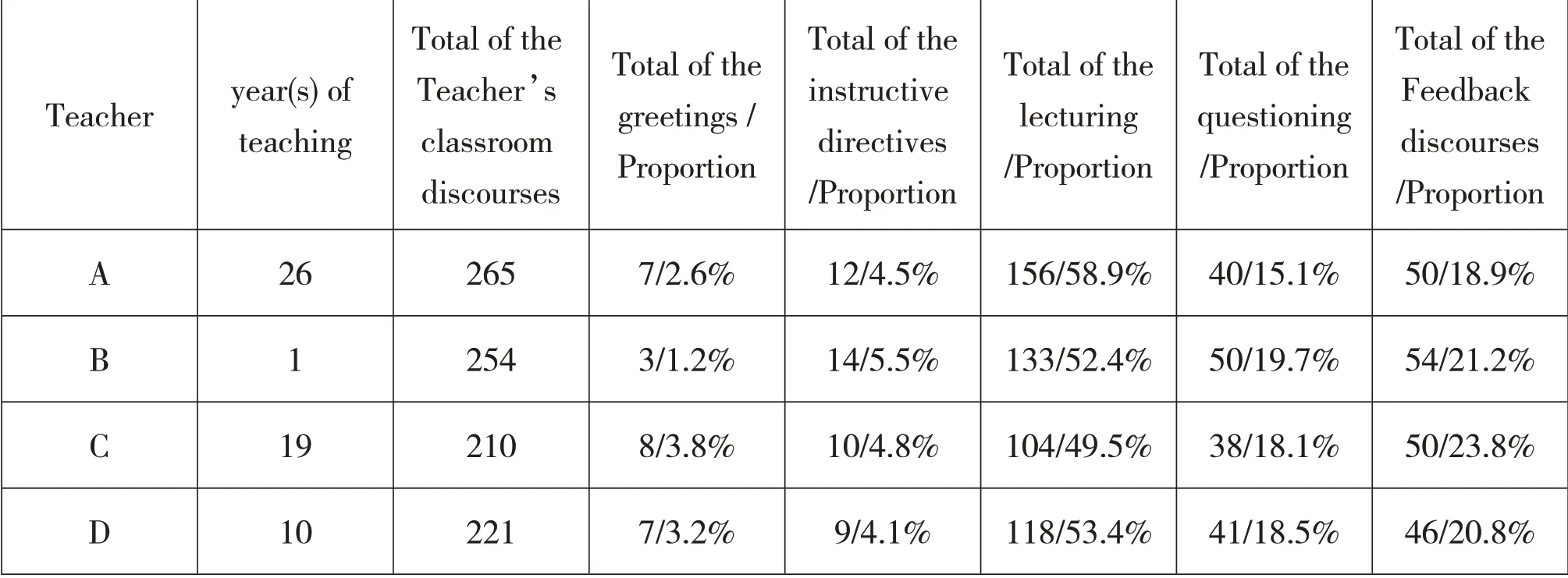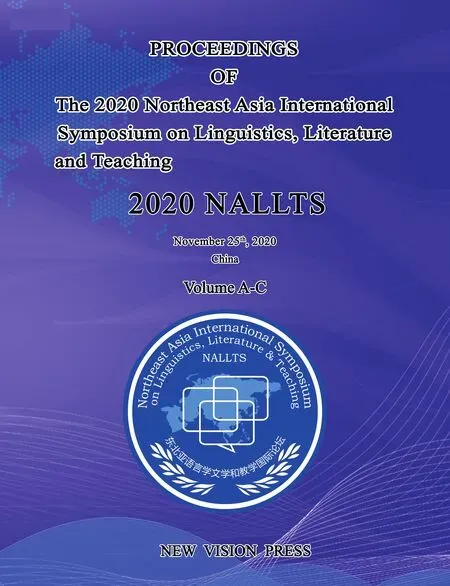English Classroom Discourse under the Perspective of Speech Act Theory
School of International Studies,Anshan Normal University,Anshan,China Email:meredith_wang@hotmail.com
[Abstract]“English Curriculum Standards for Senior High School”(2017)pointed out that in daily teaching activities,teachers should combine the theme context by using their own classroom teaching discourse to guide students to speak,dialogue,and discuss.Make English classroom a real“student-centered”classroom.This study combines the framework of locutionary act,illocutionary act and perlocutionary act to analyze the various parts of English teacher’s classroom discourse.
[Keywords]speech act theory;teacher’s classroom discourse;English teachers
Introduction
It is clearly stated inThe New Standard of English Curriculum for Senior High School(2017)that in classroom teaching,teachers should combine the topic content with their classroom discourse to guide students to speak,talk and discuss.In classroom teaching,it is necessary for them to use classroom discourse constantly to reproduce topicrelated words.Teachers classroom discourse can help students sort out text information and organize topic-related words.This shows that teacher’s discourse is not only a carrier of teacher’s teaching in classroom teaching and learner’s language acquisition,but also an important source for students to obtain language input to improve core literacy.Therefore,it is of great significance to study the current teachers’classroom discourse and find measures to enhance teacher’s classroom discourse for better education.
This present study attempts to study the use of high school English teacher’s classroom discourse in Anshan by using observation and interview.By observing the classroom records of 20 high school English teachers in Anshan,choose ten teachers of the same lesson types for research and interviewing six of the English teachers and some students who participated in classroom teaching.
Theoretical Basis and Literature review
Speech Act Theory
Speech art theory was originally proposed by John L.Austin,the British Philosopher,in the late 50’s of the 20th century.InHow to Do Things with Words(1962),he pointed out that when people speak,they are performing actions.Speech act is the smallest unit of meaning and human communication.There are three types:predicate behavior,that is,using words to express a certain idea; tenor behavior,that is,the spoken sentence has a certain power; Linguistic effect is the use of an utterance to produce a certain effect.To complete a tenor behavior,one must complete a predicate behavior.Therefore,the tenor behavior and the predicate behavior are intertwined.And there are boundaries,because many predicated behaviors do not simultaneously play the role of tenor behavior.There is also a clear difference between tenor behavior and linguistic effect.The effect produced by the former is persuasive,while the effect produced by the latter is mandatory.Searle further developed the speech act theory on the basis of Austin.
Teacher’s Classroom Discourse(TCD)
The Longman Dictionary of Language Teaching and Applied Linguisticsdefines teacher’s discourse as a language used by teachers in the teaching process.In order to achieve the purpose of communicating with students,teachers often simplify the language so that it has many features of foreign dialects or other simplified language features.Language teachers use teacher’s discourse to impart language knowledge,organize classroom activities,and conduct teacher-student exchanges.In English class,English is not only the purpose of students’learning,but also the medium of teachers’teaching.Therefore,on the one hand,teacher’s discourse has an exemplary role in the use of the target language.And on the other hand,it is also an important way for students to input language(Nunan,1991).
Many researchers have so far studied TCD from different perspectives.Liebscher and Dailey-Ocain(1983)found that teachers’different perceptions of their classroom roles affect their different feedback methods.Walsh(2002)proposed the teachers’“scaffolding”discourse function to facilitate classroom interaction.Gibbons(2003)studied how teachers built a“scaffolding”and thought that the“scaffolding”role allowed students to participate in classroom interactions for a longer period of time,with more words and more complete.In China,TCD is believed not only a language tool for teachers to organize classroom teaching,but also an important source of language acquisition for students(Wei,2014).Tang(2014)holds that TCD is the specific form of the teaching language.It is an educational language that teachers have to deep consideration and have a certain teaching purpose,which will give students a psychological shock and enlightenment.Xia and Li(2017)start from the current situation of English TCD,and believe that English teachers still have problems of random and simplistic discourse repetition in high school classrooms.Hua(2017)analyzes teacher feedback from the perspective of information feedback,which can improve many of the shortcomings of traditional teaching mode effectively.To a certain extent,the quality of teacher’s discourse determines whether the teacher can successfully complete the teaching plan and whether the student can successfully acquire the target language.
Even with so many researches have been done on the TCD,few researches has been done from the perspective of Speech Act Theory.Thus,the current paper will study high school English teacher’s class discourse from the perspective of SAT.
Research Design and Implementation
Research Questions
This present research mainly explores the following questions:
1)What is the distribution of the amount of discourses and the specific ways of asking questions and the types of feedback?
2)What are the patterns of classroom feedback discourse used by high school English teachers?
With a thorough exploration around the research questions above,the present study hopes to make further targeted suggestions.
Research Subjects
The author has observed and recorded 20 high school English teachers’of both the key high schools and ordinary high schools in City A.Among the 20 classes,all reading ones are singled out,altogether amounting to 10.The age band of all the teachers from these 10 classes varies from 27 to 52,with 2 males,8 females.The 10 classes are undergone further observation to analyze the teachers’intonation,the distribution of instructive discourse,classroom organization discourse,and feedback discourse and the specific use of individual discourse.After that,through interviews with the 10 teachers(Group 1)and some students who participated in classroom teaching,then high school English teachers’shortcomings in classroom discourse are detected.Then,in order to get a clearer understanding of their views on the using of TCD,a total of ten students from each class participating in the same classA Child of two Cuisinestaught by different teachers were selected for interviews.In addition,the article uses SAT to further analyze the teacher’s discourse.It can provide referential suggestions to promote the ability of front-line teachers to use classroom discourse.
Research Methods:Classroom Observation
Through classroom recordings,the author observes the classroom discourse usage of 20 high school English teachers in Anshan.And then take out the classroom record of ten teachers with the same course type and different teaching ages to analyze.This paper uses data and examples from the classroom recordings to clarify the classroom discourse of English teachers in Anshan:the current status and problems of the use of discourse of classroom teaching,discourse of classroom management,and feedback discourse.Through the observation method,the distribution and usage of the ten teachers’classroom discourses are counted.And the use of question and feedback in the classroom is observed emphatically.Then use the SAT to analyze and study the teacher’s discourse,and provide referential opinions for the improvement of the ability of front-line teachers to use classroom discourse.
Results and Discussion
Distribution of Teacher’s classroom discourse
Through statistical analysis,statistics on the discourse distribution of 10 teachers of different teaching ages who are all reading lessons are shown in Table 1.

Table 1.Distribution of Teachers’Discourse

E F G H I J 18 14 5 4 2 8 12 205 234 267 262 260 230 7/3.4%7/3%4/1.5%3/1.1%6/2.3%7/3.1%10/4.9%9/3.8%16/6%14/5.4%8/3.1%10/4.3%104/50.7%122/52.1%162/60.7%159/60.7%154/59.2%126/54.8%36/17.6%42/18%40/15%41/15.6%40/15.4%38/16.5%48/23.4%54/23.1%45/16.8%45/17.2%52/20%49/21.3%
The results in Table 1 show that,in general,most teachers have a large total amount of lecturing,accounting for 55.2% on average,followed by questions and feedback.The classroom greetings and instructive directives are relatively few.No matter how many years of the teachers’school age,the number of feedback discourses is more than the number of questions.Relatively speaking,teachers with more than 10 years of teaching age have more feedback discourses and less instructional words than young teachers with less than 10 years of teaching age.This shows that for a reading class where teachers have a lot of discourse in the classroom,lecturing account for more than half of the discourse.Younger teachers have less feedback than experienced teachers.In addition,teachers with more teaching age have less instructional words to organize the classroom.In general,through observation,most teachers have more utterances than students.Pica&Long(1986)once proposed that if TCD take up too much class time,students can only accept a large amount of information from teachers and their target language output opportunities are reduced passively,which is not good for students’language acquisition.Therefore,in teaching activities,teachers should control their own utterances appropriately,encourage students to speak more,and make the English classroom a truly“student-centered”classroom.
The distribution of teacher’s classroom Feedback
The distribution of teacher’s classroom feedback is showed in Table 2.in terms of negative feedback and positive feedback.

Table 2.Types of Feedback from Senior High School English Teachers

H I J Average 24 22 21 22.6 21 20 19 19.9 87.5 90.9 90.5 88 3 2 2 2.7 12.5 9.1 9.5 12
The types of teacher feedback can be divided into different categories under different research perspectives.British scholar Nunan(1991)classified feedback into positive feedback and negative feedback based on the role of feedback.Positive feedback means that the teacher responds to the students’answers positively.It includes three types:simple positive feedback,trigger positive feedback,and positive feedback with additional languages.Simple positive feedback refers to the teachers’recognition or affirmation of the student’s response,such as“Very good”,“Great”,etc.Positive feedback with additional language means that,in addition to simply affirming the student’s response,the teacher also includes additional discourses to provide students with more language information(Long,1983).Relevant research shows that most teachers tend to adopt positive feedback methods in English teaching.Its role is mainly to stimulate learning interest,enhance learning motivation and improving learners’learning behavior.In addition,even if the students did not answer the question correctly,teachers should praise the positive part of the answer instead of negating the student’s answer completely.Negative feedback means that the teacher gives a negative evaluation of the student’s response.Krashen(1985)pointed out that to a certain extent,error correction can cause students to have a defensive mentality.Therefore,excessive emphasis on language forms is not conducive to language acquisition.According to the object of it,feedback can be divided it into two types:formal feedback and content feedback.Lyster and Ranta(1997)proposed 6 types of error correction feedback:restatement,explicit error correction,meta-language feedback,clarification requests,heuristic and repetition.
Concluding Remarks
In summary,English classroom discourse under the perspective of Speech Act Theory has changed the students’learning mode to a great extent.How to make English classroom a real“student-centered”classroom? This requires teachers to properly control their own words in teaching activities and encourage students to speak more.Pica & Long(1986)once proposed that students can only receive a lot of information from teachers if teachers’classroom discourse takes up too much class time.Their target language output opportunities will be passively reduced,which is not conducive to students’language acquisition.First of all,a good start is very important for a class.Teachers should use classroom greetings correctly.Because greetings can help students naturally enter the learning state.It also can attract students’attention to prepare for class.Secondly,teachers should take instructional instructions seriously and improve their ability to use guiding instructions.If students cannot correctly understand and carry out the guiding instructions of the teacher,they will reduce their motivation to participate in the classroom.Therefore,teachers should use simple,clear,and euphemistic teaching language to make the classroom atmosphere relatively relaxed.Then the students’attention will become very concentrated.Guiding instructions must vary from person to person.This can shorten the distance between teachers and students.It can facilitate communication between teachers and students.All of these will be conducive to the development of teaching activities.
 Proceedings of Northeast Asia International Symposium on Linguistics,Literature and Teaching2020年0期
Proceedings of Northeast Asia International Symposium on Linguistics,Literature and Teaching2020年0期
- Proceedings of Northeast Asia International Symposium on Linguistics,Literature and Teaching的其它文章
- Exploration of the SPOC-based Blended Teaching Model:Case Study of Business English Course
- Reducing Students’Foreign Language Speaking Anxiety Through Drama Performance
- An Action Research on Blended Learning through News Broadcasts in EFL Listening Context
- Growth Mindset in Teaching
- A Study on Corpus Stylistics Assisted English and American Literature Teaching
- Promoting Architectural Values in Culturebound Scenery in Tourist Destinations
